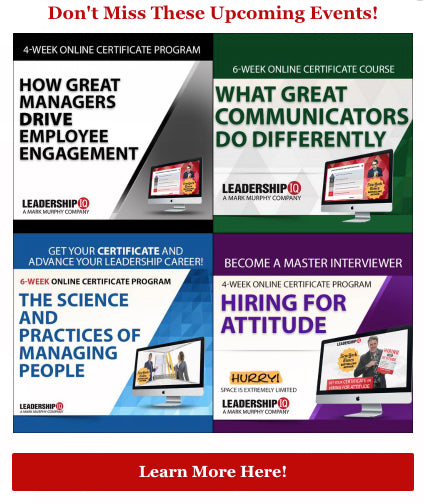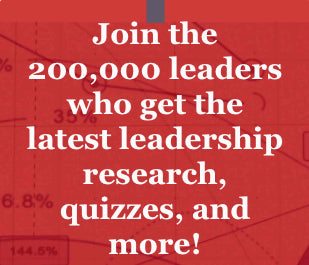Increase Your Emotional Intelligence By Watching Television
This article originally appeared on Forbes by Mark Murphy, Founder of Leadership IQ
Momma always told me that watching television and movies would rot my brain. Well, now I’ve got a great counter-argument to that, because there’s an exercise for developing emotional intelligence that involves watching television.
Emotional intelligence is just as important as traditional intelligence. In fact, lack of emotional intelligence causes hiring failures way more than lack of technical skill.
And emotional intelligence requires developing two kinds of awareness. There’s self-awareness, which involves getting a handle on personal triggers so you know what sets you off, what makes you pay attention, etc.
And then there’s awareness of others, what we like to call “other-awareness.” This is where we learn to observe and interpret the emotions of others. It’s a key part of emotional intelligence and it’s where we get to watch television or movies.
There are two parts to developing other-awareness. The first is developing our observational skills, which is all about focusing and paying attention, and the second part is interpreting those signals.
We observe all day long, but we typically don’t pay that much attention to what we’re seeing. Consider, for example, a dime. You’ve handled dimes plenty of times in your life, and you’ve had ample opportunity for observation. But can you really describe a dime? “It’s silver and ridged on the edges,” most of us will say. Fewer will know it’s Franklin D. Roosevelt’s face on a dime. And even fewer will be able to correctly say which direction his profile faces, or what’s written on the back of a dime.
This is where other-awareness comes in; it’s keying in and really paying attention and more accurately processing everything that’s going on.
So, to build other-awareness, there’s an exercise you can do the next time you watch television or a movie. It just needs to be on DVD or on-demand, any format that allows you to pause and repeat a scene a few times.
Here’s how the exercise works. First, pick a show or movie (it can be one you’ve seen before, but it’s more fun with a film you’ve never seen) that includes a scene with two or three people interacting. Avoid big action movies, as we’re looking for strong dialogue between human beings. You’re going to watch this scene where people are interacting twice: once with the sound off, and then a second time with the sound on.
The first viewing, with the sound off, you just want to observe. What are the people on screen doing? Without any sound to help you out, try and key into what is happening with these characters. Check out their facial expressions: are they smiling, staring, frowning, eyebrows raised, blinking rapidly? Are they breaking eye contact or are they holding eye contact? What’s happening to the color of their faces? Is one person’s face suddenly getting red? Who has tight lips or relaxed lips? Is someone wetting their lips?
Next look at gestures: maybe someone is nodding, or shaking, or covering their mouth or eyes, scratching their face. Where are everyone’s hands? Maybe a character is cracking his knuckles. What about their bodies? What are the angles of everyone’s heads? Are the characters close to each other or far apart? Are they slumping? Are they leaning forward? Are they shrugging? Doing this without sound removes all other distractions and just lets you observe. Then, with the sound still off, start to make some interpretations. Assess which emotions you think are present just by watching body language, facial expressions, etc.
Now watch the same scene with the sound on. And again, you want to key into the gestures, facial expressions, etc. while now also listening to the words and assessing what emotions you think are present. How do your silent observations compare to the observations you made when you had audio cues to help? How observant are you?
The next step is to take this emotional intelligence exercise back to the workplace. Meetings are a great place to do this, so the next meeting you are in, observe all the facial expressions, the gestures and the body display, and start to mentally note what emotions you think are present. What’s neat about doing this at work is you can actually test some of your hypotheses. And that’s a great way to really hone your emotional intelligence.
So after you’ve made your observations and started to figure out the emotions you think are present; come up with three possible explanations for those observed behaviors; three hypotheses.
Maybe hypothesis no. 1 is: I’m watching Jane and maybe she’s feeling sick, and no. 2 is: Maybe Jane’s upset because we’re talking about her new assignment and she’s confused by the directions, and hypothesis no. 3 is: Maybe Jane’s tired.
What we want to do is come up with various hypotheses for the behaviors we see because when we develop alternative and multiple hypotheses, it prevents us from getting fixated on just one type of solution. Once we get fixated, it’s very hard to keep an open mind about anything. But when we have multiple hypotheses for things, that is, by definition, having a much more open mind, it automatically amps up our listening abilities.
Next consider the likelihood of each of your three hypotheses by observing some more. See if you can find additional evidence, for example, in the “Jane is tired” hypothesis, you might observe: “Jane has two cups of coffee on her desk and she doesn’t usually drink coffee. She has been working late the last few nights, maybe she is tired.” If possible, you can even go to the person and say, “Listen, just curious, but I noticed you’re staring off in the sky, your arms were closed off, etc. Since we’re friends here, I wonder if I can ask you what’s going through your mind, what were you feeling right then?” That way you can find out which of your hypotheses were correct.
The goal of this emotional intelligence exercise is to be a more effective observer of human behavior and more effective at correlating those observations to your assessment of other peoples’ emotions. This allows you to develop a more effective sense of the causality of those behaviors and those emotions. And that is a cornerstone of emotional intelligence.
Mark Murphy is NY Times bestselling author, Founder of Leadership IQ, a sought-after speaker, and creator of the leadership styles assessment.








